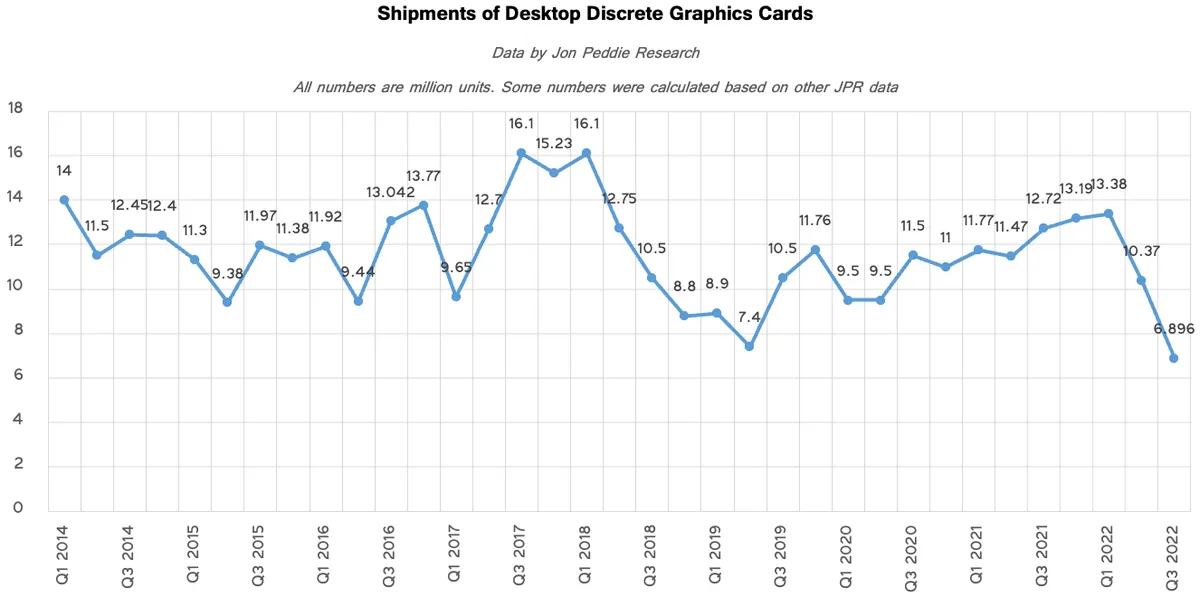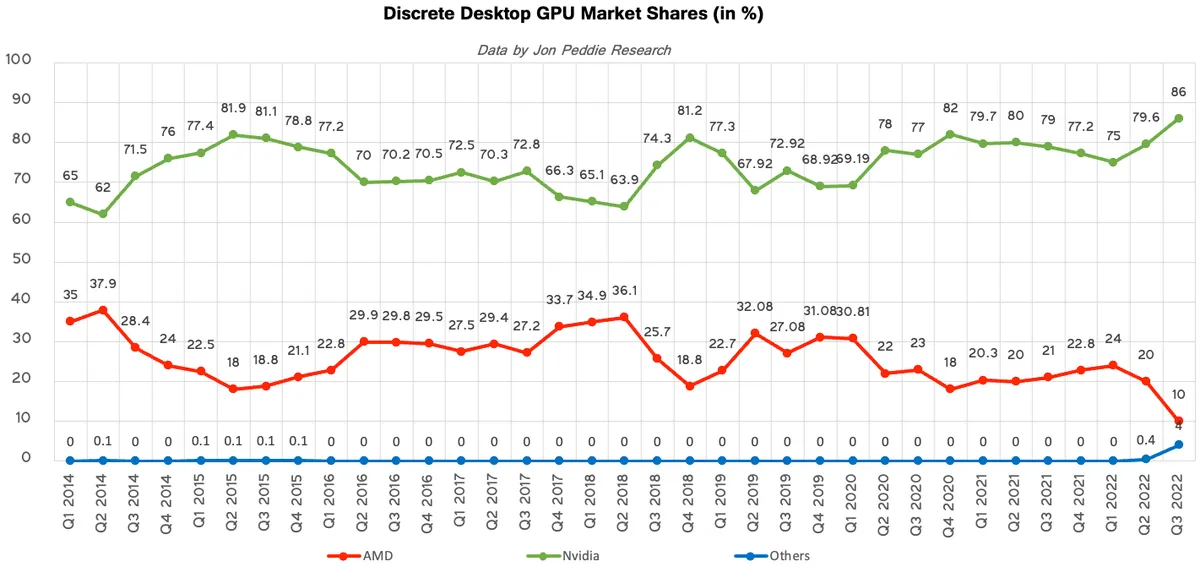The market for desktop graphics processing units (GPUs) has hit a 20-year low in the third quarter of 2022, according to data from Jon Peddie Research. Demand for GPUs had previously increased during the COVID-19 pandemic as more people spent time at home playing games or mining Ethereum, but it appears that now that the world has reopened and Ethereum mining on GPUs has died down, demand for these products has dropped significantly.
AMD, Intel, and Nvidia shipped a total of around 14 million standalone graphics processors for desktop and laptop computers in Q3 2022, a 42% year-over-year decline. This includes around 6.9 million standalone graphics boards for desktop PCs and a similar number of discrete GPUs for notebooks. In contrast, shipments of integrated GPUs reached 61.5 million units in the same period.
This decline in demand for desktop GPUs is likely due to a combination of factors, including the end of the Ethereum mining craze and the return to in-person work and school, which may have reduced the amount of time people spend gaming at home. It is possible that demand for these products will increase again in the future, but for now, it appears that the market for desktop GPUs has hit a rough patch.
According to Jon Peddie Research, the number of desktop discrete add-in-boards (AIBs) shipped in Q3 2022 was just 6.9 million. This is the lowest number of graphics cards shipped since at least Q3 2005, and considering that standalone AIBs were popular in the early 2000s when integrated GPUs were not as advanced, it is safe to say that Q3 2022 saw the lowest shipments of desktop graphics boards in at least 20 years.
The decline in demand for these products can be attributed to a number of factors, including the end of the Ethereum mining craze and the return to in-person work and school, which may have reduced the amount of time people spend gaming at home. It remains to be seen if demand for desktop GPUs will increase again in the future, but for now, it seems that the market is struggling.
Despite the overall decline in demand for discrete graphics cards for desktop computers, Nvidia was able to maintain and even strengthen its position in the market, according to data from Jon Peddie Research. The company held an 86% market share in Q3 2023, its highest ever, while AMD's share dropped to around 10%, its lowest in decades. Intel also managed to capture 4% of the desktop discrete GPU market in just one quarter, with the majority of its AIB parts being entry-level models.
While the slowing demand for discrete graphics cards may be a concern for some companies, Nvidia's strong market share and Intel's successful entry into the market show that there is still potential for growth in this industry. It will be interesting to see how the market evolves in the coming quarters as demand for these products continues to fluctuate.
While the decline in demand for discrete graphics cards for desktop computers may seem significant, it's important to consider the context of the market. In the early 2000s, shipments of discrete laptop GPUs were not as strong as they are today because there were not as many notebooks being sold. This means that in normal quarters, sales of standalone GPUs for desktops and notebooks may be more or less in line with what we saw 15-17 years ago.
Additionally, the price of GPUs has significantly increased in recent years, which has allowed companies like AMD and Nvidia to thrive despite fluctuating demand. It remains to be seen how the market will evolve in the coming quarters, but it's important to consider the overall context and trends in the industry when analyzing sales data.
According to Jon Peddie Research, the market for discrete graphics processing units (GPUs) saw a significant decline in Q3 2022, with shipments down 42% year-over-year. This marks the most significant drop in GPU sales in the third quarter since the recession of 2009.
The decline in demand for discrete GPUs was likely due to enthusiasts waiting for new products from Nvidia and AMD, as well as PC makers attempting to deplete their stocks of CPUs with built-in graphics. The overall market for GPUs also saw a decrease of around 25.1% year-over-year.
For those who have been following the discrete desktop GPU market for a long time, the current situation may seem particularly dire. However, it's important to consider the various factors that can impact demand for these products, including market trends and the release of new products. It remains to be seen how the market will recover in the coming quarters.







0 Comments